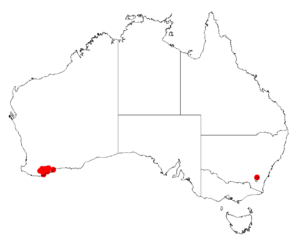Acacia declinata facts for kids
Quick facts for kids Acacia declinata |
|
|---|---|
| Conservation status | |
| Scientific classification | |
| Genus: |
Acacia
|
| Species: |
declinata
|
 |
|
| Occurrence data from AVH | |
Acacia declinata is a type of shrub that belongs to the Acacia plant family. It is special because it only grows in a specific area along the south coast of Western Australia. This means it is endemic to that region.
About the Plant
This plant is a bushy shrub with a strong smell. It usually grows to be about 20 to 40 centimeters (0.7 to 1.3 feet) tall. It often grows flat along the ground, which is called a prostrate habit.
Its small branches are round and covered in many tiny hairs. At the base of its leaves, it has small, triangle-shaped parts called stipules, which are about 1 millimeter long and don't fall off easily.
Like most Acacia plants, Acacia declinata doesn't have true leaves. Instead, it has phyllodes. These are flattened leaf stems that look and act like leaves. The phyllodes of Acacia declinata are attached directly to the stem. They spread out or bend backward, are smooth (without hairs), and stay green all year. They are mostly straight or slightly curved, measuring 7 to 22 millimeters long and 0.8 to 1.2 millimeters wide. Each phyllode has a brown tip and three lines, or nerves, on each side.
This plant blooms with yellow flowers from August to September.
Plant Names and History
The scientific name for this plant, Acacia declinata, was first officially described in 1990. Two botanists, Richard Sumner Cowan and Bruce Maslin, gave it this name. They wrote about it in a journal called Western Australian Naturalist.
Later, in 2003, another botanist named Leslie Pedley changed its name to Racosperma declinatum. However, in 2014, it was changed back to its original name, Acacia declinata, and placed back into the Acacia group.
Where It Grows
Acacia declinata is found in the Great Southern region of Western Australia. It likes to grow in soils that are a mix of loam or sandy clay.
You can find this shrub in an area between Borden in the northwest, Manypeaks in the southwest, and Boxwood Hill in the southeast. It often grows as part of tall shrubland or woodland areas.


